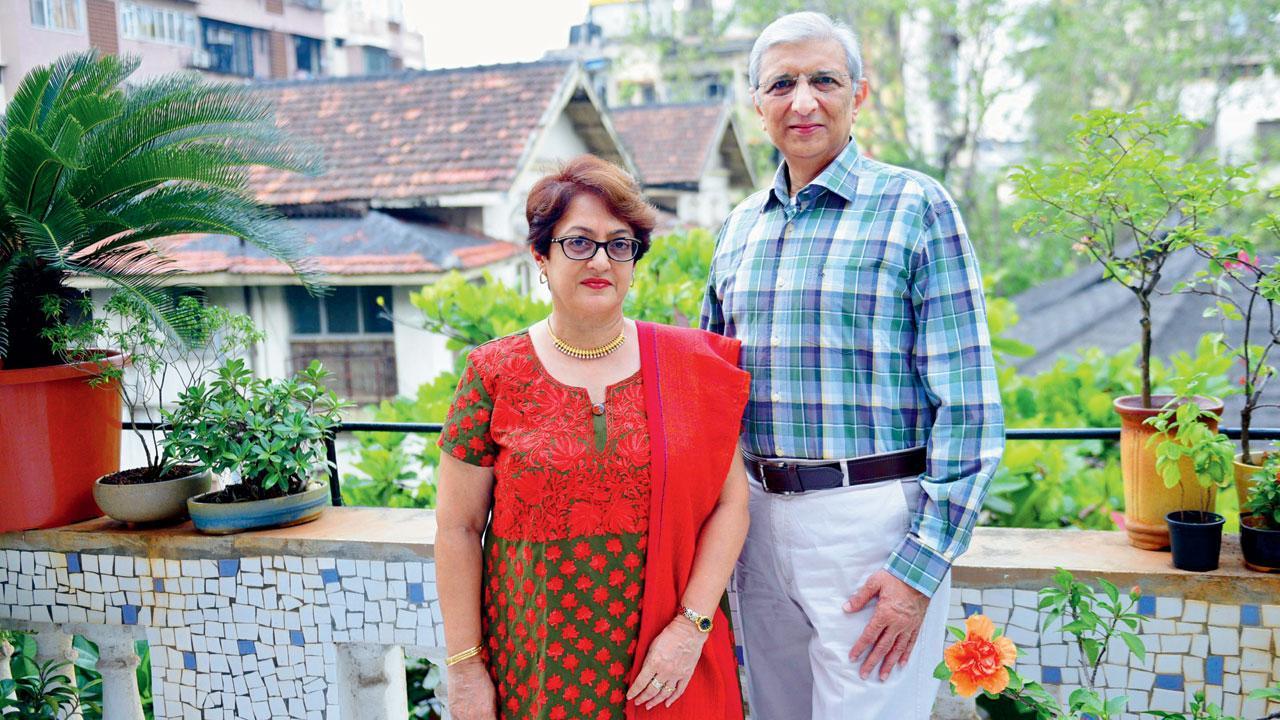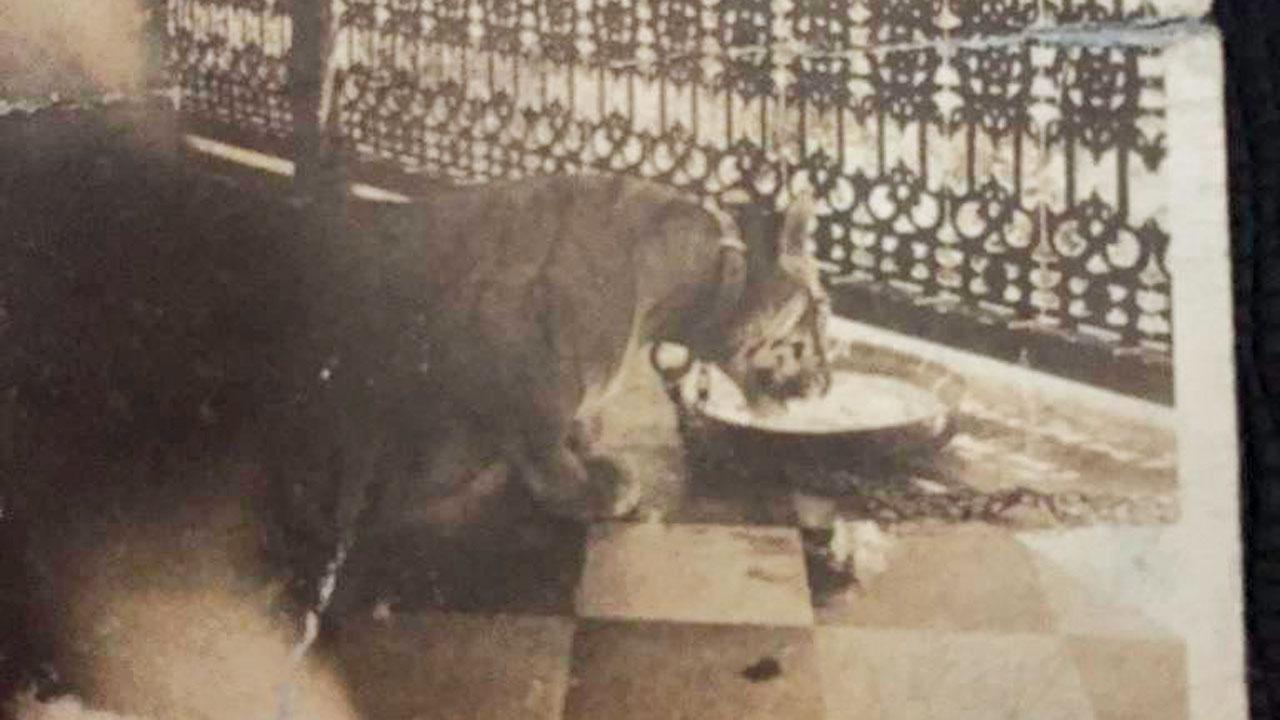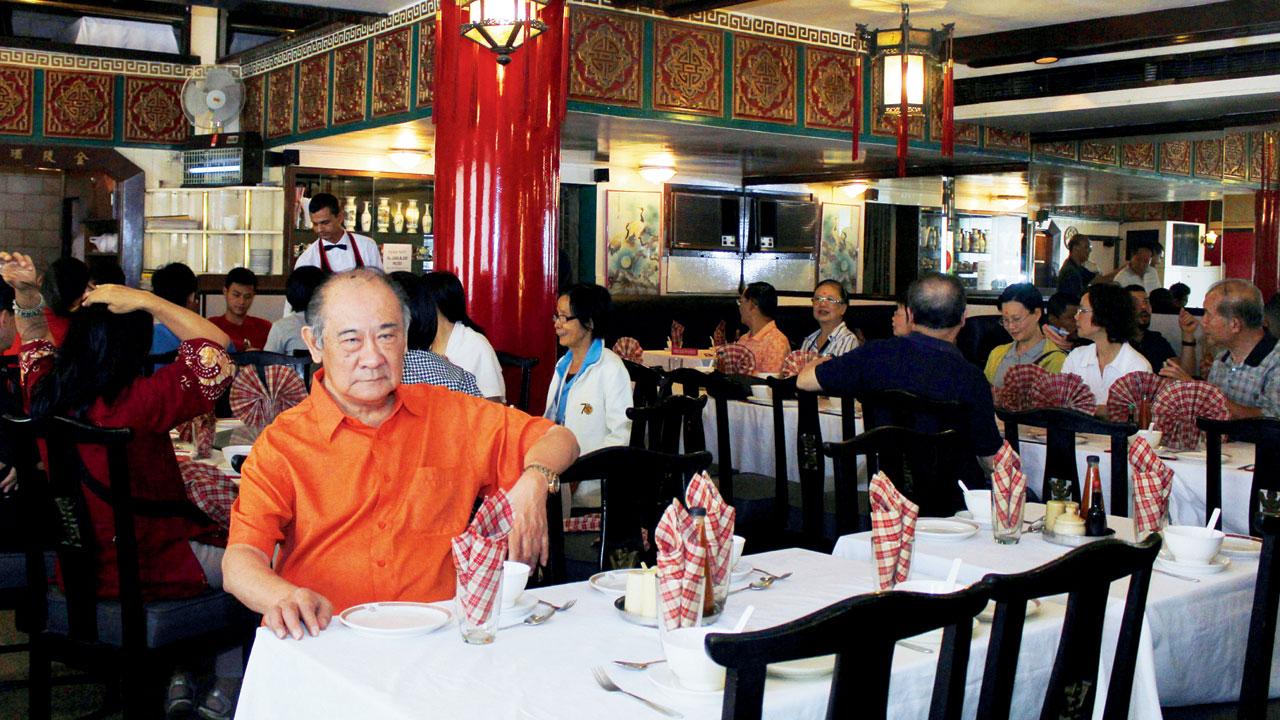This Chinese Year of the Tiger triggers Sino-Indian stories as well as accounts of Bombay big cats

Rashmi and Kumar Desai on their Khetwadi apartment balcony
 This is the fifth Chinese Year of the Tiger in my life. When it dawned on February 1, I smiled at the thought of the time my mother gave me a fountain pen to practise writing with. Almost a rite of passage, marking the transition from primary to secondary school, from pencils to pens.
This is the fifth Chinese Year of the Tiger in my life. When it dawned on February 1, I smiled at the thought of the time my mother gave me a fountain pen to practise writing with. Almost a rite of passage, marking the transition from primary to secondary school, from pencils to pens.
ADVERTISEMENT
The blue liquid from the new maroon nib pressing across the blank page, spurted the start of William Blake’s “Tyger Tyger, burning bright/In the forests of the night…” That I’d also thrilled to the gallop of what was trochaic tetrameter verse, I picked up in prosody class much after. Then, it was enough being treated to a Chinese meal (unaccustomed indulgence in the early 1970s), for inking those dramatic lines.

The pet tiger cub his grandfather brought home
How insistently such childhood associations linger. That savoured memory, teamed with what this Chinese year represents, calls to mind some favourite stories about both, the Chinese in Bombay and a couple of rather intriguing city tigers.
Even those viewing China as aggressor remain ever loyal patrons of its immigrants’ cuisine. One restaurant patronised by loyal generations was Kamling. Diners including Krishna Menon, Shashi Kapoor and Deng Xiaoping’s son Deng Pufang, loved the traditional decor—red walls hung with brush paintings and lanterns swaying to speaker-piped Oriental music.
 Kotnis offering flowers at the tomb of Canadian, Dr Bethune, who served in the same area; Dr Dwarkanath Kotnis and Dr Vijaykumar Basu (first and third from left) with Chinese colleagues. Pics Courtesy/Dr Sumangala Kotnis Borkar
Kotnis offering flowers at the tomb of Canadian, Dr Bethune, who served in the same area; Dr Dwarkanath Kotnis and Dr Vijaykumar Basu (first and third from left) with Chinese colleagues. Pics Courtesy/Dr Sumangala Kotnis Borkar
Opening in 1939, Kamling shut after the 1962 Indo-China war, going into receivership with the original owners in dispute. How Tulun Chen came to repossess the iconic eatery, with a menu of over 400 Cantonese and Hunan dishes, makes a story warmer than the soup bowls steaming up his tables.
Cut to the mid-1960s when Chen, the 18-year-old son of a dentist, was returning from a show of The Guns of Navarone at Ballard Pier’s Rex Cinema with friends. Witnessing an elderly Chinese man knocked down by a cab, the boys admitted him to hospital. When he recovered, they realised the accident victim was the Kamling proprietor. Pooling in money, they paid for his R3,000-passage back to Hong Kong. As he departed, the gent put a piece of paper into Chen’s hand, saying “This is yours.” Gratitude for the so-very-Bombay kindness of strangers... It was the sale deed for Kamling, confirmed by a solicitor’s letter which followed.
 Tulun Chen at Kamling, the restaurant he got in appreciation from a gentleman he helped. File pic
Tulun Chen at Kamling, the restaurant he got in appreciation from a gentleman he helped. File pic
Moving on to an interesting journey of uncommon sacrifice in a life cut too tragically short. While working on Proctor Road, east-flanking Grant Road, I stopped at Model House, where the family of Dr Dwarkanath Kotnis lived after his untimely death in China in 1942. (Remember V Shantaram’s film Dr Kotnis ki Amar Kahani?)
Sholapur-born Dwarkanath Shantaram Kotnis was gutsy right from his Bombay collegian days. In the second MBBS year at KEM, he opposed a pro-British dean replacing Dr Jivraj Mehta. Expelled for the outspokenness, he left for Grant Medical College.
Kotnis joined an extraordinary medical mission India extended China in 1938, aiding reparation of soldiers during the second Sino-Japan War. Nehru received a letter for help from Commander-in-Chief Zhu De, of the Eighth Route Army. Though warned that volunteering would be fraught with danger, Kotnis stuck to his commitment.
Details of that eventful sojourn are revealed in The Inspiring Legacy of Dr Kotnis, a recent video presentation by his niece, Dr Sumangala Kotnis Borkar. The youngest of four medicos, he headed farther east aboard the SS Rajputana for a fortnight-long sail. “Dwarkanath diligently began learning the new language from fellow passengers. Reaching their destination, he could communicate in broken Chinese,” says Borkar.
Toiling day and night, Kotnis saved the seriously injured with gruelling operation hours. He walked up to 30 miles every day in excruciatingly chilly weather across bad hilly roads, risking capture or torture in Japanese-occupied terrain. He tenderly nursed at least 800 wounded soldiers. Assigned the task of developing an x-ray and surgery section, he performed complicated pain-relieving procedures with courage and conviction.
When the rest of the team went back to India, Kotnis alone stayed on. He succumbed on the warfront to an epileptic episode. Years after, it was in Model House that his Chinese wife Guo Qinglan celebrated the sixteenth birthday of their son, Ing Hua—named to mean “flower of India and China”.
Inundated with respect, bouquets still pile at Dr Kotnis’ tribute monument in Shijiazhuang. To quote Madame Sun Yat Sen: “His memory belongs not only to your people and ours but the roll-call of fighters for freedom and progress of all mankind. It was for the future that he struggled.”
Wandering through our city of hidden gems, amid the messy maze that Khetwadi’s 14 lanes seem to be fast reducing to, I observed no more than a fistful of structures which were a feast for sore eyes. One is the Bhagini Samaj building, opposite what was handsome-in-stone Tara Mansion—we all but weep to note its hideous tower replacement today—where singing star Munni Bai lived from the 1940s. Khetwadi was Manmohan Desai’s turf, where the movie mogul grew up. His cousin, Kumar Desai, third in an ancestral line of four lawyers, resides in an airy Bhagini Samaj apartment on Khetwadi Main Road.
Kumar’s wife Rashmi showed me around the flat that used to have a charming little big cat pad about. Theirs is one of the three striking “Arab Buildings” erected by Mustafa Bin Abdul Latif. The first bungalow is demolished. The second is Vanita Vishram School, clad in antique gallery grills from 1915. Latif’s agent Kantilal Variawalla was a jeweller. “A floor below us, men winnowed tiny pearls like grain,” Kumar recollected. Rooms held clues to cloistered zenana quarters, where invisible women peered out from slats in windows lowered to street level.
The rear balcony sheltered a tiger cub Kumar’s grandfather rescued. A blurry but delightful sepia print portrayed it bent over a feeding bowl there. The last to hold the combined post of Court Receiver and Liquidator, Balwantrao Desai accompanied Indian and British officers on the occasional weekend hunt. The family lavished attention on an orphaned tiger Balwantrao brought home with initial trepidation. Reaching Alsatian size, the cub needed to be sent to the Mysore Zoo. Alarming telegrams soon flooded the Desais: the animal was stubbornly refusing to eat. Raised vegetarian, he shunned meat.
Diet tweaked, he thrived. After all, theirs was a Khetwadi-striped Gujarati baby!
A feline presence is believed to have evocatively christened certain midtown acres. Trees planted in Raja Bhimdev’s rule lent 13th-century Bombay localities their names. Parel derived from the paral (trumpet flower), just as Wadala is said to have stemmed from wad (banyan). More colourful is the claim that a fierce tiger once prowled through the area. Majestic, with eyes glowing and tail flicking the ground, he trod downhill daily. The Marathi “wagh dola”, tiger eyes, became Wadala. I was offered this explanatory legend by Kazim Ahmedji, from the Sunni family of mujawwar caretakers, whose ancestors served saints at Shaykh Misri Dargah. The terrace tomb of trader turned preacher Shaykh Misri, believed to come from 15th century-Egypt, lies within a cool brick enclosure.
To leap five centuries ahead for a quirkier tiger allusion. Though Irani restaurants flourished between the World Wars, orthodox Hindus resisted meat on the menu. South Indians stepped in sanguinely, establishing simple places providing Bombay immigrants coffee and “tiffin”, wholesome hometown food and drink. People met here, formed networks, bonded in firm friendships. South Kanara families continue to host a range of customers paying modest tariffs from Rs 300 to Rs 1,200.
Sujata Pilinja Rao runs Vasantashram near Crawford Market with panache and passion. It was set up in 1947 by her father Pilinja Laxminarayan Rao, with his brother Subba Rao catering Udupi meals. Vasantashram, on the third floor of Narasinh Mansion, was where elephants were tethered when the Maharani of Jaipur visited. Sujata took over as managing partner after her father’s death in 2002 and actioned a cheerful restoration. An artist-guest from Ghaziabad splashed vivid folk motifs on almirahs, old ladders and beams were innovatively repurposed as light fixtures, and disbanded ship lanterns from Darukhana line corridors and a long street-facing balcony.
Bravely balancing economics with emotion, the copywriter turned businesswoman faced chauvinism, of course. One man in particular kept taunting Sujata with unasked, completely idiotic advice: to focus on her child more than work. She invoked her maiden name. Pilinja means “tiger” in Tulu. With a temper likened to hot pepper sambar, she told him nothing short of an AK 47 would hold her down.
Author-publisher Meher Marfatia writes fortnightly on everything that makes her love Mumbai and adore Bombay. You can reach her at meher.marfatia@mid-day.com/www.meher marfatia.com
 Subscribe today by clicking the link and stay updated with the latest news!" Click here!
Subscribe today by clicking the link and stay updated with the latest news!" Click here!







